5 Examples of Push Notification Actions Done Right

Reading Time: 9 minutes
| 👉 Download Report: Find out how your Mobile Gaming brand can optimize its push campaigns to drive high retention rates!
👉 Push Notification Reach Estimator – Use the calculator to find out if your notifications are actually reaching your users and what you can do about it. 👉 Download Whitepaper – Learn how to boost Boost User Engagement By Maximizing Push Notification Delivery Rates. |
Push notification is your gateway to increased customer engagement and conversion rate. A single push notification to new customers can increase retention rates and get them hooked to your brand.
Marketers can send instant iOS app or Android in-app messages to customers without too much preparation. These alerts can keep your customers informed of the latest updates, time-sensitive offers, events, and more at a literal click of a button.
Naturally, this can boost your app open rates, improve retention, keep your customers engaged, drive product awareness, improve product promotions, increase trust in the brand, and enhance the customer experience—as long as the text input is timely, relevant, and contextual.
But here’s the twist: App interactions that pop up on the ‘home screen’ aren’t enough to keep your customers coming back for more.

This means marketers must send strategic push notifications at critical time stamps within the day to drive user engagement and boost the conversion rate. In this guide, we’ll learn how. Let’s go!
But First, What Are Push Notifications?
Push notifications have been branded many names over the years—actionable notifications, user taps, or remote notifications—correctly so.
A push message is basically a short message that encourages your customer to take a desired action. It is sent to the customer’s mobile devices or desktops via a website or an app. You can add rich media content to it, such as images, videos, GIFs, and more, to improve its relevance.
Personalization based on user preferences is an important characteristic of getting the right notification response. For instance, you can send reminders to customers who have forgotten important items in their cart using a push message.

What Are Push Notification Actions?
Now that you know what push notifications are and how they help drive the app opens, it’s time to learn about push notification actions—which are nothing but a natural progression in the push notification journey.
Push notification actions allow customers the freedom to perform ‘app actions’ or complete ‘tasks’ directly from the message without opening the app.
With this type of easily delivered notification, app marketers have the levee to solve two major problems: drive app usage and app retention – by repeatedly reminding the customers of the value the app delivers.
Why Push Notification Actions are Central to Driving App Engagement

We’ve understood what push notification actions entail. Now, let’s move on to how they can drive app engagement:
- They encourage customers to complete specific actions and drive quick decisions. Look at the example below from MoMusic, which motivates customers to swipe up and listen to their favorite songs that have been personally recommended by the brand.

- They allow marketers to send action-oriented, behavior-triggered push notifications in the key ‘micro-moments’ of a customer. The idea is to engage customers and help them interact with the brand without opening the app. The communication is direct, easy to follow, and not effort-intensive at all, as shown below.
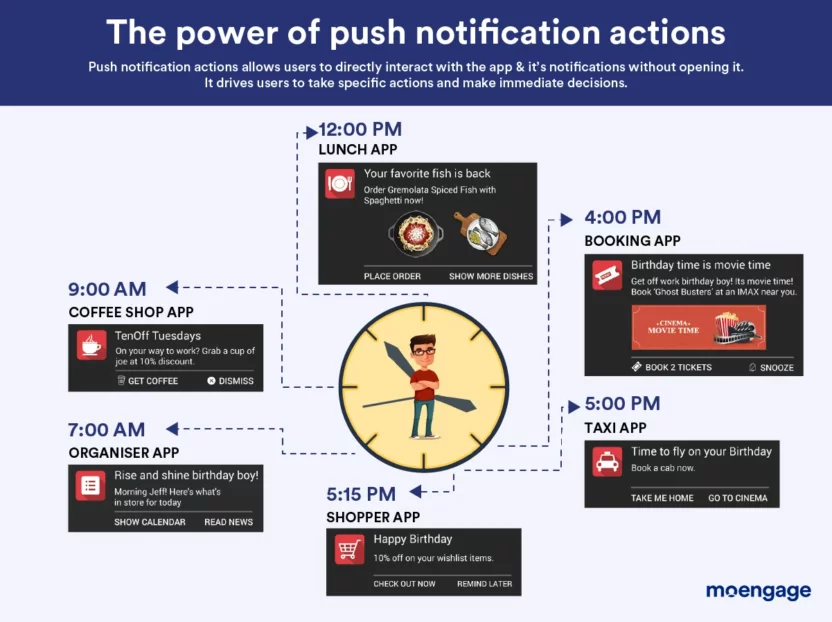
| Further Reading: Learn more about how push notification actions can drive mobile app conversions with data-backed insights. |
5 Push Notification Actions Worth Getting Inspired By
In the previous section, we got an overview of push notification actions. Let’s look at a few real-life examples of push notification campaigns that help drive engagement and app usage.
Example #1 – Provide a clear call to action to drive revenue
One of the primary objectives of building mobile device apps is to drive revenue through the app. With every transaction that’s completed on the app, you can get one step closer to recovering your investment.
Sure, discount coupons, sign-up vouchers, etc., are significant in driving sales. However, push notification actions can elevate the customer experience by informing your customers about the latest offers and giving them a clear call to action, which can trigger a purchase.
Additionally, sending push messages increases app retention rates by 3 to 10 times, and adding actionable notifications in CTAs can boost push notification campaign outcomes by 40%! How so? An actionable call to action button helps customers to take a well-defined ‘action’ that adds value to your overall messaging.
Use-Case: How Berrybenka Achieved 14X Increase in Customer Engagement and Conversion Rates
Objective: The leading Indonesian fashion brand wanted to:
- Identify opportunities and build a unified customer experience across channels
- Provide personalized, targeted engagement experience to customers
- Boost marketing growth by leveraging marketing automation
The solution: Berrybenka leveraged MoEngage’s superior user analytics platform coupled with machine-learning powered engagement channels (push, deep linking, web push notifications, and in-app messaging) to inform customers about the latest offers while delivering a cohesive customer experience across channels.
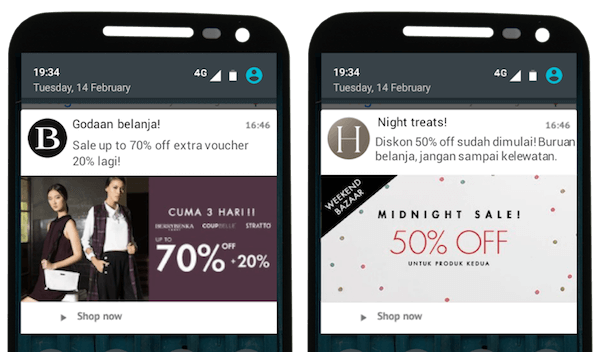
In the above example, Berrybenka and Hijabenka accompany their notifications with clear notification action buttons and value-added messaging to achieve amazing results.

Example #2 – Accomplish tasks without opening the app
Sometimes, customers may not remember your app as most of them rarely browse beyond the home screen, right? So, it’s the marketers’ responsibility to not just remind customers of the app but also inform them about the functions/tasks it can accomplish. This is where push notification actions come into the big picture.
Use-Case: How Policybazaar Adopted a Proactive Approach to Engagement
Objective: To make informed decisions using data and analytics and improve push delivery as well as overall engagement.
The solution: Policybazaar leveraged pushes for five different customer cohorts, each with different insurance needs and preferences.
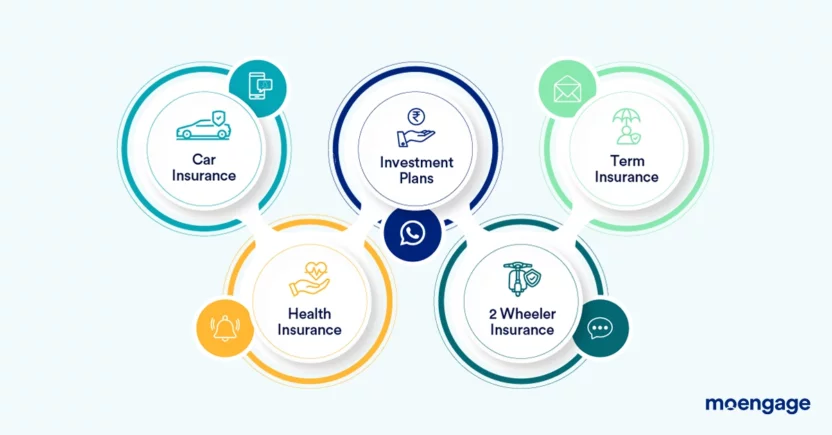
The idea was to use push notification actions for encouraging app-related tasks such as exploring plans, investing, purchase-driven actions, and more, and driving more user taps.

| Pro tip: Using phrases like ‘remind later’ and ‘explore now’ can deliver a better overall app experience and empower customers to take the desired action at their convenience. |
Example #3 – Guide Customers with Clear Actions to Avoid the Swipe Trap
Push notifications are infamous for sometimes catching your customers off guard and causing confusion. Customers may not be clear on how to act on it at the moment, which can lead to the swipe trap. In this scenario, using push notifications can help guide your customers to take the necessary action.
Use-case: YouTube Gives the Power to Customers with Flexible Call-to-Action Options
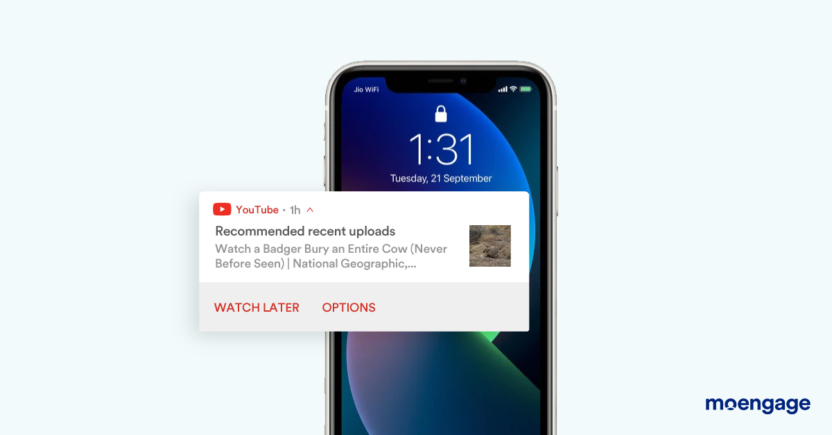
In the above example, the YouTube app effortlessly manages to:
- Notify app customers about new uploads from channels they are subscribed to
- Allow customers to control when they want to watch these videos by adding push action buttons such as ‘Watch Later’ and ‘Options.’
The trouble with push-action buttons is they can seem intrusive at times. So, shift gears and let your customers get into the driving seat by allowing them to control when they want to watch these videos. Adding CTA buttons such as “Watch Later,” “Remind Later,” “Others,” etc. can guide customer actions and make them feel at ease.
Example #4 – Defer Tasks for a Later Time
As marketers, we’re all sometimes forced to send out push notifications even when we know the customer might be busy—a big mistake. Irrespective of how willing your customers might be to act on your notifications, they may just not find the time needed to complete the desired action (like completing a booking or a purchase, for example) after opening the notification. Who can blame them? Let’s look at what Mamaearth and Grofers did to solve this.
Use-case: How Mamaearth Successfully Increased Delivery Rates by 219%
Objective: Mamaearth wanted to unlock increased customer
loyalty and retention using MoEngage.
The solution: Mamaearth, a leading baby care brand, used a combination of custom actions (read: email campaign and push notification) to promote an ongoing sale.
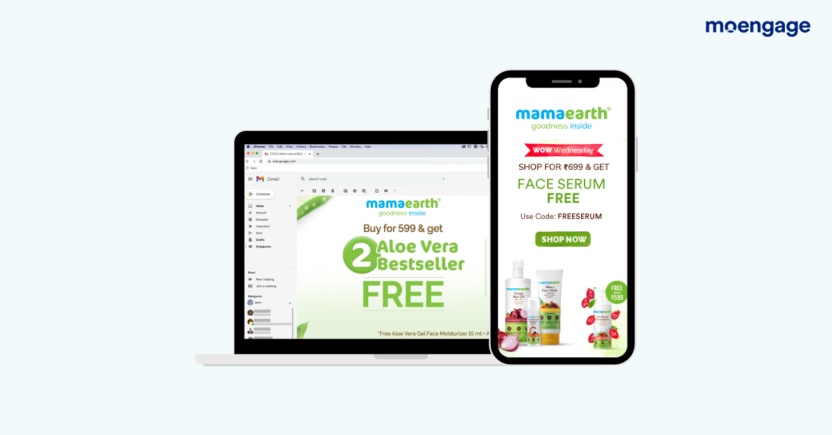
What this push notification action does is remind customers about the sale while adding an element of time (having lasted 4 hours) to give them space and allow them to complete the purchase on their own time.
The results:
- 219% uplift in the push notification delivery rates
- 26% increase in repeat customers by using targeted segmentation and hyper-personalization
| Pro tip: You can elevate the push notification experience by ‘reminding’ customers about the sale in an hour’s time, as Grofers does below. |
In another example, a mobile app by a leading telecom service provider allowed customers to perform transactions such as recharge, transfer money, pay bills, etc., through mobile apps. You can read the whole case study on our website. Adding an element of personalization with push actions can also increase the response rate for these notifications.
Example #5 – Improve your overall app experience
Push messages are great for driving action-oriented tasks such as ‘update an app,’ ‘give us a rating,’ and more. This may not seem important at first, but customers on an older version of an app pose serious challenges to app companies.
After all, newer app versions are usually lighter, faster, and relatively bug-free, which can help app companies deliver an overall better experience to customers.
Use-case: How Indiamart Improves the Overall Customer Experience with Push Notification Actions
In the following example, Indiamart sends out push notification actions that explain the benefits of why customers need to update their app, along with a clear call to action.

The ‘Update now’ notification button clearly spells out what the customer must do to proceed.
What will your push notification actions strategy look like in 2023? Here are 21 brilliant push notification ideas to get inspired by and make your own for a killer in-app experience.
Customer Concerns Around Push Notifications—And How to Solve Them
Not all customers think of push notifications as a welcome alert on their mobile device or desktop. There’s the ethical challenge of balancing customer privacy and app interaction. Plus, protecting your customer’s data from unauthorized access or misuse must be a high priority.
In addition to these, customers often have trouble understanding:
- What kind of data is being collected
- What kind of data is the organization sharing with other third-party entities
- How is the data being used
- Is the data being used to drive targeted advertising
To address these valid concerns, here are some best practices that can mitigate privacy concerns while managing notification fatigue:
- Frequency: A staggering 92% of app customers will not discontinue the use of the app, while 87% will not turn off push notifications if they receive a single push notification per week. Clearly, sending out push messages at the right frequency is important to avoid reject buttons!
- Value-driven: Pushes should be optimized to your customer’s behavior, tastes, and interests to boost top-of-the-mind recall but with caution. The data being used to personalize them must be accessed legally. And you must strive to send messages of value. This includes exclusive content, meaningful product info, incentives, and more.
- Transparency: Make sure to get consent and permissions before you start sending pushes to your customers. You must also be transparent about how and why you’re using the customer data. Plus, you must enable customers to opt in/opt out of messages as needed.
- Data Security: Keep monitoring your push campaign efficiency and leverage secure technologies such as anonymization and encryption to boost data protection. You can also implement robust user authentication procedures and implement strong access controls to add an extra layer of security for your customer’s sensitive data.
- Compliance: Finally, make sure that your push messages are compliant with the latest laws and policies (think GDPR, CCPA, etc.). Conducting regular audits will help you stay on top of your compliance requirements.
Win Customers in the Moment with Push Notifications
Push notification actions, when done right, are a great tool for marketers to channel—and drive— customers toward taking the desired action. In simpler words, they prevent customers from pressing the dreaded reject buttons within in-app messaging.
From the five examples we saw above, we know that you can use in-app messages to drive app-related tasks and deliver an overall better experience for app customers without them ever leaving the app!
Customers benefit from a stellar experience, whereas the brand can drive greater conversions. It’s a win-win for all.
Want to know how brands like Bigbasket, Travelz, and Oyo Rooms use MoEngage Push Amplification to improve their push notification delivery rates? Learn more about push amplification here.







